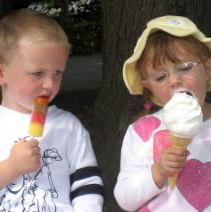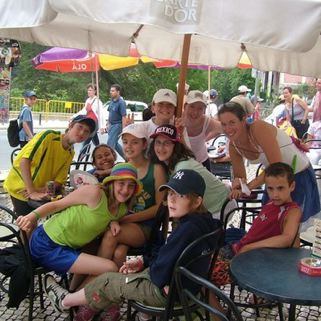 Last summer when Lydia Herman went to camp she slept on an air mattress in a junior-high classroom in Findlay, Ohio.
Last summer when Lydia Herman went to camp she slept on an air mattress in a junior-high classroom in Findlay, Ohio.
There was no lake. No ocean or pool. No arts and crafts. No horses.
She didn’t learn about computers. Or play science games. Take drama or a sport.
But every morning when she woke, she heard “good morning” in 12 different languages.
When the flag was raised and the national anthem sung, the kids let loose with the “Stars and Stripes,” but they also raised the flags and sang the anthems of 11 other countries – the countries of the other campers. These kids had journeyed to this camp from Brazil, Turkey, Thailand, Guatemala, Honduras, Germany, Italy, Canada, India, Costa Rica, and the Philippines.
While most camps spend the first week helping kids get to know one another, this camp spends the first week doing that, plus teaching them how to pronounce each other’s names.
So what is this camp that pops up for a month each summer in more than 60 countries of the world? It’s called the Village and it’s the brainchild of Dr. Doris Allen. She started it in 1951 in response to the devastation caused by World War II. Convinced that the only way to stop the madness was to promote cross-cultural friendships, she started camps open only to 11-year-olds, with four kids and a leader representing communities around the world.
Why 11-year-olds? Dr. Allen theorized that kids in that age group are old enough to be away from home, but still open enough that they can get beyond the language barriers. “You hand them a ball or a water balloon and they find a way to communicate,” says Lydia’s mother, Michelle.
Run by the non-profit Children’s International Summer Villages (CISV) the Village may be just for kids but getting there involves the whole family. Because CISV is run by volunteers (a.k.a. parents) the cost is relatively low ($400 for Lydia to go to camp for a month) but the time commitment is big.
 Before the kids ever leave for camp, they’ve had a multitude of get-togethers with the campers from their own community. Lydia lives in Pittsburgh—last year the local chapter of CISV met throughout the year so the kids could build relationships, whether it was creating a play about their culture or putting together scrapbooks to exchange with the delegations from the 11 other countries. “The reason I do it is because I know that somewhere in the world other parents are getting together and doing the same thing for my kids,” says Michelle.
Before the kids ever leave for camp, they’ve had a multitude of get-togethers with the campers from their own community. Lydia lives in Pittsburgh—last year the local chapter of CISV met throughout the year so the kids could build relationships, whether it was creating a play about their culture or putting together scrapbooks to exchange with the delegations from the 11 other countries. “The reason I do it is because I know that somewhere in the world other parents are getting together and doing the same thing for my kids,” says Michelle.
Once the kids are at camp, communication with their parents is verboten. “I thought I was going to miss my family, but because you can’t communicate with your parents you have to rely on the other kids to cheer you up,” says Lydia. “Now I miss the other kids more than I missed my parents when I was away.”
So what do they do all day? If you read the CSIV literature or ask a parent, you’ll hear about the games the kids play to promote cross-cultural understanding, the field trips to learn about the host country, the weekend home stays with families. If you ask Lydia, she says, “Have fun! Like each morning a different delegation got to wake everybody up and when it was our turn we threw water on everyone. Some of the [kids from] other countries were really nice about the way they woke people up but after the first time, they got the hang of it.”
Then there were the pillow fights, water balloons, talent shows, and the on-going poker game played for Guatemalan friendship bracelets. In other words, 48 kids from 12 countries spent a month being kids.
Or as Michelle’s son Ellis said when his parents asked him what he’d learned about the world by spending a month at a Village: “I learned they’re all like me. They’re all just kids.”
And whether good morning is said in English, Spanish, Portuguese, Thai or German, isn’t that the point?
By Jamie Simons for PeterGreenberg.com.
Check out more articles from the Grateful Traveler series.
Learn about more Summer Camps for the Whole Family.
Read the article that started the series: An Eskimo Showed Me the Way.












